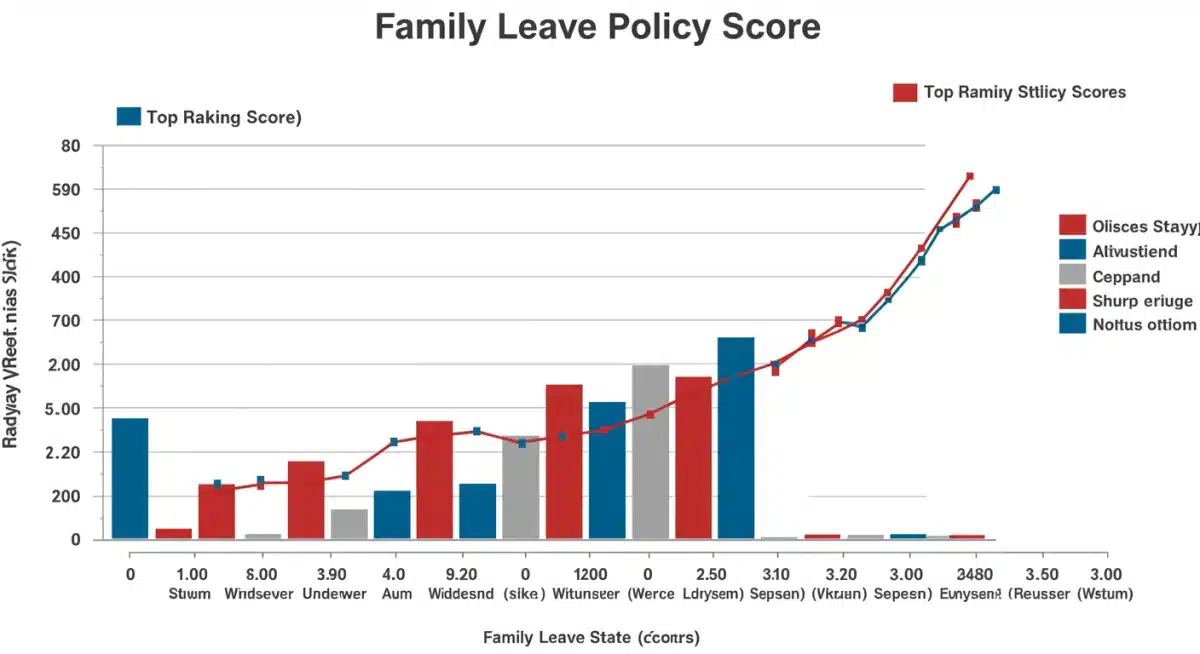New Report: States with Best Family Leave Policies Ranked

A new report released today provides a comprehensive ranking of states with the best family leave policies, offering crucial insights into the support systems available to working families across the United States.
Breaking news for working families across the nation: a significant new analysis has just been released, detailing the most supportive environments for parental and caregiver responsibilities. This New Report: States with the Best Family Leave Policies Ranked offers a critical look at which states are leading the charge in providing essential support, and what those policies entail. Are you curious if your state made the cut, or what makes a policy truly ‘family-friendly’?
Understanding the New Report’s Methodology
The recently published report, compiled by the National Partnership for Women & Families, utilizes a robust methodology to evaluate and rank states based on their family leave provisions. This comprehensive assessment goes beyond mere existence of policies, delving into the specifics that truly impact working individuals and their families. The aim is to provide a clear, data-driven picture of where states stand in terms of supporting their workforce through life’s significant moments.
Researchers meticulously analyzed various legislative components, considering both statewide mandates and the accessibility of benefits. This includes examining the scope of paid leave, job protection clauses, and the inclusivity of these policies for diverse family structures. Understanding this methodology is key to interpreting the rankings and appreciating the nuances of effective family leave.
Key Metrics for Evaluation
Several critical metrics underpinned the report’s evaluation process. These factors were weighted based on their direct impact on a worker’s ability to take leave without significant financial or professional repercussions. The report emphasizes that a truly supportive policy encompasses more than just time off; it ensures financial stability and job security.
- Paid Leave Availability: Assesses whether states offer paid family and medical leave programs, including the duration and wage replacement rates.
- Job Protection: Examines the extent to which a worker’s job is protected while on leave, covering both state and local mandates.
- Caregiver Inclusivity: Evaluates if policies extend beyond parental leave to include care for sick family members, domestic partners, and chosen family.
- Wage Replacement Levels: Considers the percentage of a worker’s typical wages replaced during leave, crucial for economic stability.
Top-Ranked States and Their Exemplary Policies
The report shines a spotlight on several states that have distinguished themselves as leaders in family leave. These states have implemented policies that serve as benchmarks for others, demonstrating a commitment to supporting their residents through significant life events such as childbirth, adoption, or serious illness within the family. Their progressive approaches offer valuable lessons for policy-makers nationwide.
California, New Jersey, and New York consistently appear at the top of the rankings, lauded for their comprehensive paid family leave programs. These states have not only established paid leave systems but have also continuously worked to expand their scope and accessibility, ensuring a broader segment of their workforce benefits from these vital protections.
California’s Pioneering Approach
California stands out as a pioneer, having implemented the first statewide paid family leave program in the U.S. in 2004. The state’s program provides partial wage replacement for workers who need to take time off to bond with a new child, care for a seriously ill family member, or manage their own serious health condition. Recent expansions have further enhanced its reach and benefits.
- Duration: Up to 8 weeks of paid family leave.
- Wage Replacement: Currently provides 60-70% of wages, depending on income.
- Job Protection: Strong job protection under the California Family Rights Act (CFRA) for eligible employees.
The Impact of Robust Family Leave on Workers and Businesses
The benefits of robust family leave policies extend far beyond individual workers; they create a ripple effect that positively impacts businesses and the economy as a whole. Research consistently demonstrates that when employees feel supported during critical life moments, they are more engaged, productive, and loyal. This translates into tangible advantages for employers, including reduced turnover and increased morale.
Businesses in states with strong family leave programs often report lower recruitment and training costs due to improved employee retention. Furthermore, these policies contribute to a more equitable workforce, allowing women and other caregivers to maintain their careers without sacrificing family responsibilities. This fosters a more diverse and inclusive workplace, which has been shown to drive innovation and financial performance.
Economic Benefits and Worker Retention
Economically, paid family leave can stimulate local economies by ensuring that families have stable income during periods of leave, allowing them to continue spending. This stability is particularly crucial for low-wage workers who often cannot afford to take unpaid leave, forcing them to choose between their income and their family’s needs. The availability of paid leave helps reduce poverty and income inequality.
For businesses, the long-term gains often outweigh the initial perceived costs. Employees who utilize paid leave often return to work with renewed dedication and reduced stress, leading to higher productivity. The positive public image associated with offering supportive policies also aids in attracting top talent in competitive markets.
States Falling Behind: Areas for Improvement
While some states are forging ahead with progressive family leave policies, the report also identifies numerous states that are significantly lagging. These states often offer minimal or no statewide paid family leave, leaving workers reliant on federal mandates like the Family and Medical Leave Act (FMLA), which provides unpaid leave and only covers certain employees. This disparity creates a patchwork system where access to essential support depends heavily on geographic location.
The report highlights a critical need for legislative action in these areas to ensure that all workers have access to the basic protections needed during family and medical emergencies. Without these provisions, many individuals, particularly those in lower-income brackets, face immense financial strain and difficult choices between their health, their family’s well-being, and their livelihood.
Common Gaps in Underperforming States
States with less robust policies typically exhibit several common shortcomings. These often include a lack of paid leave, insufficient job protection, and narrow definitions of who qualifies for leave or who can be cared for. Addressing these gaps is crucial for improving family support nationwide.
- No Paid Leave Program: Many states lack any form of statewide paid family or medical leave, forcing workers into unpaid leave or no leave at all.
- Limited Job Protection: Even where leave is available, job protection may be weak or absent, leaving employees vulnerable to job loss.
- Narrow Eligibility: Strict eligibility requirements often exclude part-time workers, temporary employees, or those in smaller businesses.
- Inadequate Wage Replacement: For the few states with some form of paid leave, wage replacement rates can be too low to provide meaningful financial security.
Federal Efforts and the Push for National Standards
The varying landscape of state family leave policies underscores the ongoing debate at the federal level regarding the implementation of national standards. Advocates for a federal paid family and medical leave program argue that a unified approach is necessary to ensure equitable access for all American workers, regardless of where they live or the size of their employer. This push for national legislation aims to close the gaps left by inconsistent state-level efforts.
While the Family and Medical Leave Act (FMLA) provides 12 weeks of unpaid, job-protected leave for eligible employees, it does not address the crucial issue of wage replacement. This financial gap remains a significant barrier for many workers, particularly those living paycheck to paycheck. Momentum continues to build for a federal paid leave program, with various proposals being discussed in Congress.

Current Legislative Landscape
Several legislative proposals have been introduced in recent years aimed at establishing a national paid family and medical leave program. These proposals vary in their scope, funding mechanisms, and the level of wage replacement offered. The discussions often highlight the economic benefits of such a program, including improved workforce participation and reduced reliance on public assistance.
The ongoing challenge lies in finding bipartisan consensus on a framework that can be implemented effectively across all states. As of now, the U.S. remains one of the few industrialized nations without a national paid family leave policy, making state-level initiatives all the more critical for working families.
How State Policies Are Evolving and What to Expect
The landscape of family leave policies is not static; it is continually evolving as more states recognize the economic and social benefits of supporting working families. The new report not only provides a snapshot of the current situation but also serves as a catalyst for further legislative changes. Expect to see increased pressure on states with lagging policies to adopt more comprehensive programs, driven by both advocacy groups and public demand.
Many states are actively studying the successful models implemented by top-ranked states, seeking to adapt similar provisions to their own unique economic and demographic contexts. This trend suggests a gradual but steady movement towards broader access to paid family and medical leave across the nation. The conversation is shifting from whether to implement paid leave to how best to implement it.
Emerging Trends and Future Outlook
Several key trends are emerging in the family leave policy arena. These include a focus on expanding definitions of ‘family’ to be more inclusive, increasing wage replacement rates to ensure greater financial security, and extending the duration of available leave. Technology is also playing a role, with some states exploring streamlined application processes for benefits.
- Expanded Definitions of Family: Growing recognition of diverse family structures, including domestic partners and chosen family.
- Increased Wage Replacement: Efforts to raise the percentage of wages replaced during leave, making it more feasible for all income levels.
- Longer Leave Durations: Some states are considering extending the maximum period of paid leave available.
- Simplified Access: Initiatives to make applying for and receiving benefits less complicated for eligible workers.
| Key Aspect | Brief Description |
|---|---|
| Report Focus | Ranks states based on comprehensive family leave policies, including paid leave, job protection, and inclusivity. |
| Top States | California, New Jersey, and New York lead with robust paid family leave programs and strong protections. |
| Impact | Robust policies lead to increased worker retention, improved morale, and positive economic benefits for states. |
| Future Outlook | Expect continued evolution towards broader access, expanded definitions of family, and increased wage replacement rates. |
Frequently Asked Questions About Family Leave Policies
Paid family leave is a policy that allows workers to take time off from work to care for a new child or a seriously ill family member, or to address their own serious health condition, while receiving a portion of their wages. It helps ensure financial stability during critical life events.
According to the new report, states like California, New Jersey, and New York consistently rank highest due to their robust paid leave programs, strong job protection laws, and inclusive definitions of family members eligible for care. These states serve as models for others.
No, the federal Family and Medical Leave Act (FMLA) provides eligible employees with up to 12 weeks of unpaid, job-protected leave for certain family and medical reasons. While it guarantees job security, it does not offer wage replacement, which is a significant barrier for many workers.
Robust family leave policies benefit businesses by reducing employee turnover, improving morale, and increasing productivity. They also help attract and retain talent, leading to lower recruitment and training costs, and fostering a more diverse and engaged workforce.
The trend indicates a growing movement towards more comprehensive family leave policies across the U.S. Expect to see more states adopt paid leave programs, expand eligibility, increase wage replacement rates, and work towards more inclusive definitions of family, driven by public demand and advocacy.
What Happens Next
As this new report on states with the best family leave policies gains traction, the spotlight intensifies on legislative bodies across the nation. The findings are expected to fuel ongoing debates at both state and federal levels, potentially catalyzing new policy proposals aimed at strengthening family support. Advocacy groups are likely to leverage these rankings to pressure lawmakers in lagging states, pushing for reforms that align with the most progressive models. We anticipate a continued dialogue on the economic and social imperatives of comprehensive paid family leave, with a focus on how to bridge the existing disparities and ensure all working families receive the support they need to thrive.





